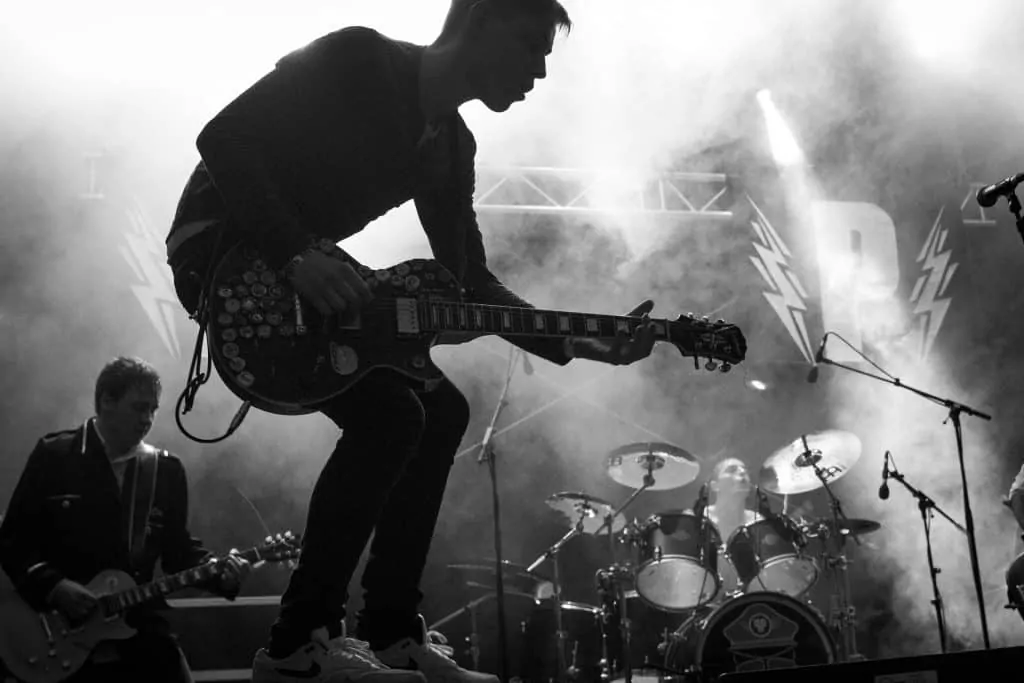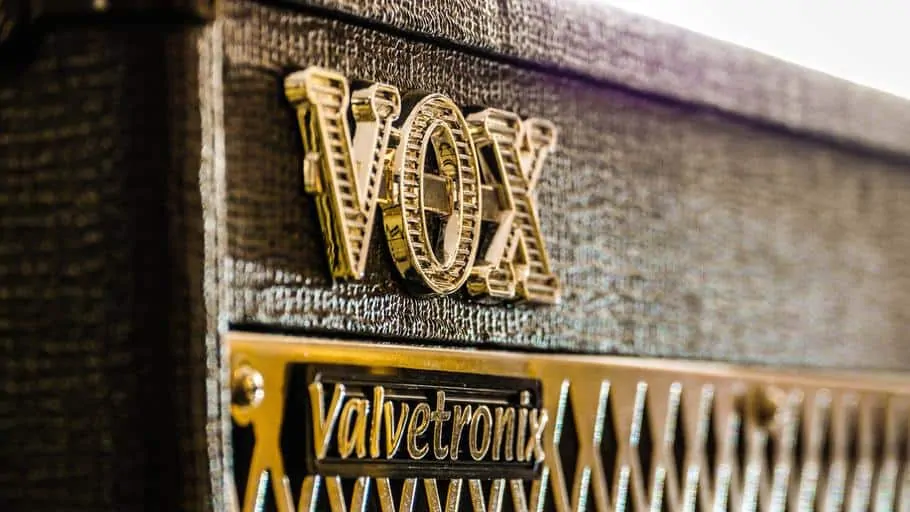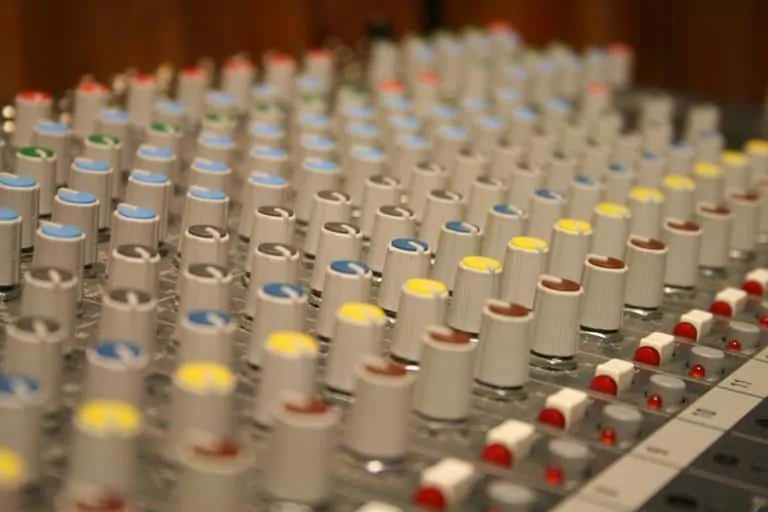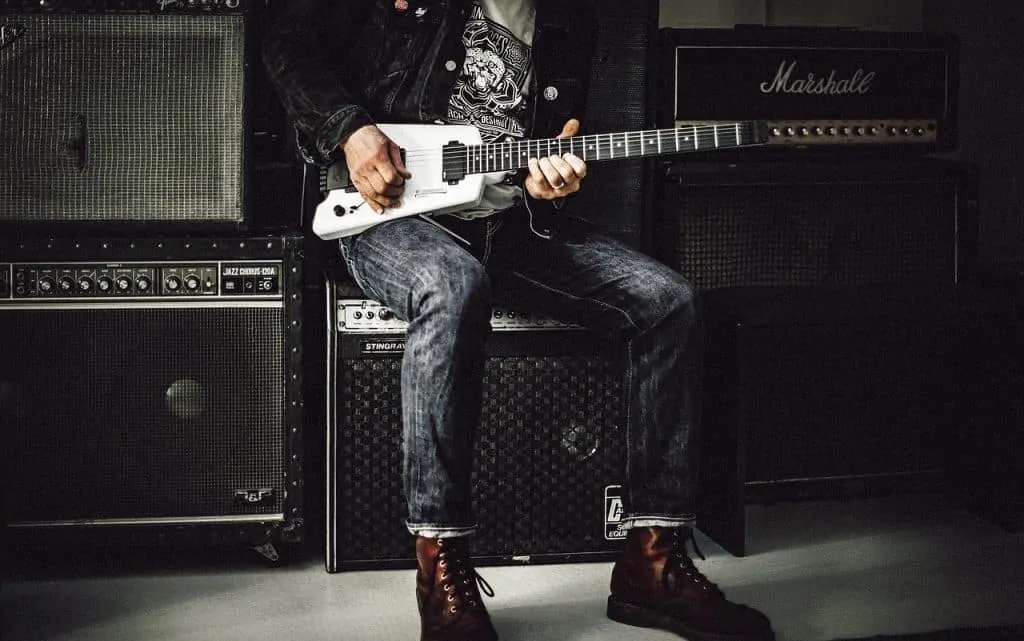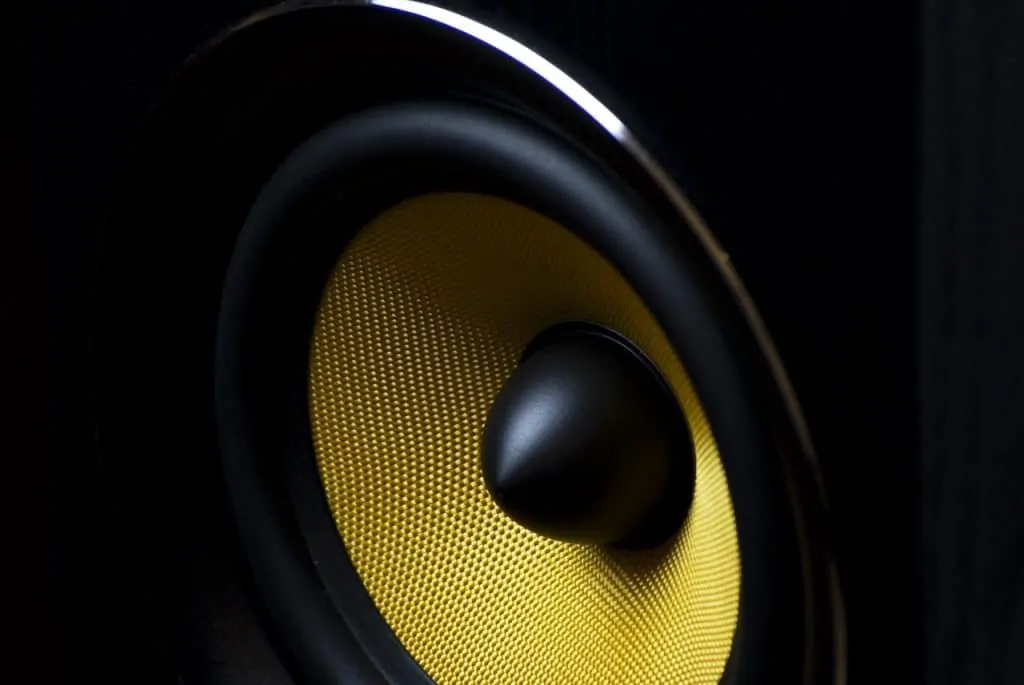There are basically four kinds of electric guitar amplifiers: tube amps, hybrid amps, modeling amps, and solid-state amps.
If you’re a beginner guitar player, I can forgive you for not knowing about this. See, what I call “solid-state” amps you may simply known as the everyday, standard guitar amplifiers.
And fear not, as I’m here to help you choose the best one for you, either if you’re a pro guitar player, an enthusiast looking to go pro, or a beginner searching for the best budget guitar amps.
Contents
Are we talking budget or not?
Solid-state amps are the cheapest kind of electric guitar amplifiers. And although we’re giving you the top 5 budget alternatives, we’re also going to share the top 5 best of the best.
What I’m saying is yes, it’s going to be a budget article, for the most part.
How cheap are we talking about, thought? Well, we’re talking about two-zero ciphers, about what you could be paying for a mid-range Android phone.
As for budget amps, these are also great for beginner guitar players. See, a beginner amp is easy to customize and use, cheap, packs the most important electric guitar amp feature, and delivers a great, consistent sound.
So let’s begin our search!
We’re looking for affordable solid-state amps as well as the best of the best alternatives.
Following this guide, you will learn:
- A brief history of solid-state amps, where do they come from?
- Why should you pick a solid-state amp over other guitar amps?;
- Guitar heroes using solid-state amps;
- What to look for in solid-state amps?;
- The top 5 electric guitar solid-state amps;
- The top 5 budget solid-state amps (also for beginners);
- Final Considerations.
In the meantime, here’s how a top-tier solid-state amp sounds like:
Where do solid-state amps come from come from?
I always start my articles by giving you a bit of context. I believe knowing about music is not only great in conversations, but also the best guide towards the exact gear you need.
The first electric guitar amps were valve tube amps, which used vacuum tubes in its system to amplify the sound and leave it untampered.
These amps were the result of studying ways to make the acoustic guitar louder.
Guitar pickups came by the 1930s when Leo Fender of the Fender shop was also beginning to study ways to transform electric currents into amplified sounds.
By the time, big rock bands were arriving at big stages, and thus guitar players needed technologies to make their guitars louder. Guitar players used acoustic guitars amplified with a microphone, which later became electro acoustic guitars and, soon enough, fully-fledged solid-body electric guitars plugged into an amplifier.
By then, the world was already seeing big bands, and guitar players were in dire need of making their instruments louder. Guitar players were using acoustic guitars, which are completely drawn below the other musicians.
Early guitar players used microphones to amplify their sound.
The solution came with the pickup, manufactured by Adolph Rickenbacker of the Electric String Company in 1930. It was perfected by George Beauchamp, a Hawaiian steel-guitar player, manufactured the first electric guitar with a pickup back in 1942.
By the way, if you want to know more about pickups, you can check this electric guitars buyer’s guide.
Electric guitar researchers knew they needed an extra method to amplify the guitar other than a P.A. system. They were looking for an additional output source that could translate the guitar’s pickup into music.
Hence, researches modified P.A. systems and Hi-Fi radios to create valve tube amplifiers.
Valve tube amps used rectifier tubes to create the sound. The Van Nest for the Electro String Company created the first guitar amp in the 30s decade.
It was a valve tube amp, which became the industry’s early standards. Valve tube amps used rectifier tubes to turn the electrical currents into music. Tubes have the advantage of delivering a cleaner, warmer, and, for most cases, better sound. However, these amps are expensive and need regular maintenance.
These early amps were small 10-watt speakers until Fender created the original 50-watt amplifier with 12” speakers in 1949.
Later on, in the 60s, guitar players started playing with high gain outputs and discovered distortion and overdrive sounds. And as rock became the mainstream music, the demand for bigger and louder amps became more significant.
In 1965, music shop owner Jim Marshall created the world’s first solid-state speaker. Furthermore, it was the world’s first 100-watt amplifier, which used four 12” speakers and was designed for the overdriven sound that defined an era.
By the 70s, solid-state amps began pushing valve tube amps aside as they became the mainstream option. These alternatives are cheaper and easier to build.
In recent times, solid-state amps have evolved to modulate the warmth tones valve tubes are loved for; as well as adding some sort of rectifier tubes in either their preamp or amp system to improve its sound (hybrid amp).
Are you ready to pick your first, or next, electric guitar amp?
I should add solid-state amps are the go-to choice for keyboard and bass guitar players. Tube amps don’t present advantages for these instruments, so they changed to solid-state amps during the 60s and 70s.
Why should you pick a solid-state amp?
Solid-state amps are the standard electric guitar amps. You’ll find them at most guitar shops, either physical or online. More so, you’re already hearing it in the music all around you.
I do vouch for tube amps as they sound better, maintain and even improve the quality of a top electric guitar, and deliver that vintage, warm sound that makes the guitar sound so good and thrilling.
If you’re wondering how valve tube amps sound in recent music, check any Foo Fighters’ song or, better yet, any Stone Temple Pilots’ single.
Solid-state amps, as well as tube amps, works toward the goal of transforming the guitar’s signal into sound.
The process both do deliver a different result in terms of sound quality and tone. Tube amps keep a vintage warmth and offer a cleaner and louder overdriven sound. And solid-state amps tend to be more crunchy and deliver a more consistent sound.
First of all, let’s discuss how a tube amp produces sound vs. how the solid-state amp produces sound. It will help you understand better and, thus, choose the perfect gear for you.
What is a solid-state amp and how does it works?
Let’s start this section by explaining the difference between the two main kinds of guitar amps.
According to music site Musician’s Friend, a valve tube amp uses rectifier tubs to amplify the sound. Engineers call these tubes” valves.” A “valve” or vacuum tube is an empty and sealed glass tube controlling electrical torrents passing through it. With the help of three electrodes, the tubes translate the electrical current into a signal for the speakers.
On the other hand, a solid-state amp uses electronics such as transistors and diodes to amplify the signal. The difference between the two is very noticeable. And transistors always change the sound one way or another.
In simpler terms, solid-state amps boost the incoming signal, whereas tube amps enhance the electrical current straight from your guitar thanks to its semiconductors (Fender).
Next, let’s review how are they different.
Difference between solid-state amps and valve tube amps
It’s important to understand these amp categories are different in both sound and design. Furthermore, they are different in the advantages and disadvantages they have, so keep that in mind.
For example, whereas a solid-state amp has simple electronic circuits working to deliver your sound, tube amps typically need output transformers to drive the signal into the speakers.
So, stereo tube amps (with two speakers) have 3 vacuum tubes either at the rear or on top to turn the output voltage into a powerful electrical current for the speakers. This is the reason why valve tube amps are louder and why you can play with high gains without losing the quality and stability of your sound.
More so, these amps offer a “dynamic overdrive,” which means you can turn your distortion on and off simply by the strength of your strumming. They do often come with a distortion channel, plus a footswitch, so buying extra guitar pedals to enhance your sound is totally up to you.
They are also “touch sensitive.” This means that when you set the distortion, you can roll down the volume knob and get a clean sound again, as Fender explains.
I must also add that this dynamic distortion is not 100 percent reliable or constant, or, at least, not as consistent as the distortion a solid-state amp could offer.
In summary, here are the three main particularities of tube amps:
- They are louder and more powerful. A small 10-watt speaker can be as powerful as a 30 or 50-watt solid-state amp;
- They offer a dynamic distortion. As you put a high gain and high volume on your valve amp, you can get an overdriven sound with a strong strumming, or a warm and clear clean with a soft strumming;
- The distortion is also touch sensitive as turning the volume up and down when your rock distortion is on you can get in an out distortion.
- The dynamic distortion is not very consistent.
Vox is one of the most reputed valve tube amp builders.
Solid-state amps are simpler and, ironically, offer way more versatility. These amps use a single power transformer (like a transistor), and no output transformers.
As they have no valve tubes, the sound doesn’t turn out as warm and rich as tube amps.
On the other hand, the distortion is consistent. Turning on the distortion or overdrive switch is all the control you need for that rock sound you’re looking for. In dire contrast to tube amps, you would need to strum your guitar with a constant strength in order to get a consistent sound.
And whereas tube-amps offer a vintage sound that’s great for classic rock or classic-rock inspired music, solid-state amps are much more versatile. They can range from rock-pop to heavy metal, alternative rock, modern blues, and anything your mind can imagine and your fingers can play. And by the way, here’s a great guide to improve your guitar skills.
Additionally, these amps are not as loud as tube amps, but they are more affordable. So, the price for a 10-watt tube amp can be the same as a 30-watt solid-state amp. Keep in mind though that you won’t be able to play with high volume gains in most amps as you would lose the quality of the sound.
As the site Masterclass explains, solid-state amps can’t handle heavy amp distortions effects. So, for example, most of Metallica’s propulsive trash guitar solos come straight from the amp (usually tube-based Mesa Boogie cabinets).
Lastly, solid-state amps are more sturdy, reliable, and require much less maintenance than tube amps.
Here’s the summary:
- They are affordable amps;
- They are less powerful than tube amps;
- The sound in more versatile;
- The distortion is more reliable;
- The sound quality is lower than tube amps, although this is debatable.
- They can’t handle heavy amp effects.
Fender adds getting the touch sensitive, dynamic distortion on a solid-state amp is the most difficult thing to find. However, you can still get it in top-tier amps like the Fender Mustang series.
For more information on valve tube amps, you can check this guide.
Hybrid electric guitar amps
Keep in mind many top-tier amps are mixes of both kinds, which is why they are called “hybrids.” It means they use tubes as their tone-shaping system, whereas a modern circuitry handles the power.
Hybrid amps have almost the same tonal warmth as tube amps, but you can still find them particularly different than the other two categories.
While tube amps are generally the most expensive in both initial costs and operations (because you will need to change the tubes every 6 months or so), solid-state amps are more reliable and less delicate. Well, hybrid amps combine the best of both worlds: the reliability and sturdiness of a solid-state amp plus the tone of a tube amp.
As for the price, it’s what you would expect: they are just in between solid-state amps and tube amps.
YOu can check the video below about one of my world’s favorite hybrid guitar amps, the Vox AV30 Hybrid.
Modelling electric guitar amps
Modeling amps are newer in the market. These are solid-state amps that emulate the response and tone of a tube amp digitally. However, they only emulate specific tube amps.
As Fender explains, the existence of modeling alternatives only fuels the ongoing debate about tube versus solid-state amps.
Modeling amps add extra digital processors to recreate the sound, effect, and tones of a variety of tube amps. A great example is the Fender Champion 50XL, so check it out.
Modeling amps are the state of the art right now. They are light, portable, and carry their whole processing power on a computer chip. As they carry plenty of effects and sounds onboard, they are a great alternative to lower the weight of carrying a massive pedalboard to every venue and rehearsal.
Furthermore, when it comes to onboard options, modeling amps are probably the most versatile of the bunch.
Fender is probably building the most ambitious modeling amps in the market right now.
Now that you’ve read all this, let’s put it in simpler terms: why would you pick a solid-state amp over the other alternatives?
Picking a solid-state guitar amp
The list below shares the reasons why you should pick a solid-state amp.
- Durability:
As vacuum tubes are made of glass, there’s a constant chance these tubes might break. In particular, tube amps constantly going on the road are more susceptible to break.
On the other hand, solid-state amps are increasingly more durable because they have a circuit-based amp method. More so, they only need maintenance once every two years (or once every year, depending on the quality of electronics), as you would need to change the circuits to keep out buzzes, hums, and other noises.
- Affordability
I’ve stated this several times during the article and, still, I feel inclined to repeat it.
There’s a general rule you must follow: don’t spend more money on your guitar amp than on your guitar. So if you must fit a budget, it’s always better to the electric guitar you would want to use on your gigs, your rehearsals, and practices, rather than picking an uber-guitar amp your guitar won’t do justice for.
As solid-state amps are more affordable than other categories, you’ll be able to buy a bigger, meaner, and more powerful amp for the price of a small 10-watt tube amp.
Going for brands like Marshall, Fender, Orange or Roland will assure the quality of your amp, even if it’s a budget alternative.
And even if tube amp’s sound quality is better, by paying a bit more on your solid-state amp you can get similar, top-quality tones.
- Modern circuitry
Solid-state amps use circuitry-based amplification methods. It means their power is condensed on computer chips and modern electronics, so it’s only a matter of time until technology finally surpasses decades-old rectifier tubes.
In recent years, solid-state amps makers have been advancing with built-in effects and sound options. For many guitarists, these amps, and especially modeling amps, lower the need for effect pedals.
What kind of guitar player do you want to be? A modern one or a vintage guitarist?
At the end of the day, it’s just a matter of opinion. Sound enthusiasts will always prefer a tube amp. However, you can always choose either a solid-state or a modeling amp if you’re not into the vintage feel.
There’s a legend saying every pro-guitar player goes with a tube amp, and that’s only half the truth. Many famous guitar players have chosen solid-state amps, and we’re about to take a look at them.
Top 4 famous musicians playing on solid-state amps
Plenty of famous guitar tones were created through complex and advanced transistors. It’s a dirty secret in the high-guitar-society because it stands in direct opposition of guitar lore.
In a fictional world were rectifier tubes are the Goddesses of tone (yes, I imagine they are females), solid-state amps are, in theory, only for beginners, eccentrics, or simply contrarians.
History, facts, and singles sing another song entirely. See, there’s an important number of iconic, revolutionary, and inglorious guitar players, composers and musicians using top brands like Fender, Roland, Marshall, Sunn, Kustom, and others. All of which deliver reliable, rich tones with just the right drops of sweat vintage juice.
Modern solid-state amps are, to be honest, really good. Whereas they were terrible digital specimens two decades ago, 2010 onwards transistors are filling VIP requisites.
The thing is a guitar player can push its tube amps up to eleven but needs to play a solid-state amp within its recommended operating parameters.
Playing live with a solid-state amp requires more digital control than playing with a tube amp.
Lately, sound and electrical engineers have figured out how to add the advantages of a tube amp into more digital alternatives. It was contrarian, even eccentric on their part, and such is the kind of attitude needed to create and improve art and, in particular, manufacture the signature tones of the following musicians:
-
Josh Homme
Josh Homme is the infamously weird Queens of the Stone Age frontman, singer, guitarist, and composer. More so, he’s one of my favorite musicians.
According to Reverb, uses a couple of Tube Works RT-2100-ES MosValve heads. These are solid-state amps with a transistor power section. However, he started his career at Kyuss using a Marshall JCM900 tube amp plus an Ampeg 8×12 bass cabinet.
I should say Josh Homme is known for a particular guitar style that somehow erases notes from blues and jazz scales plays on to give music that decadent, chaotic style trademarked by QOTSA.
Homme decided early on to develop his guitar style instead of following someone else’s. You can do it too, and here’s a fun way to start.
-
John Foggerty
John Fogerty is a famous songwriter and guitar player. He’s the mind behind singles like “Born on the Bayou,” “I Heard it Through the Grapevine,” “Susie Q,” and many of Creedence Clearwater Revival all-time classics.
Fogerty used a Rickenbacker guitar and a Kustom solid-state amp on his early days. However, thanks to the influence of Jimmy Page and younger Jeff Beck, he adopted a Gibson Les Paul as his guitar and moved to an even more modern Kustom amp with an onboard fuzz circuit.
-
Andy Summers
Acclaimed THe Police guitar player Andy Summers uses a Roland JC-120 solid-state amp. It has a built-in hypnotic stereo chorus that is yet to be improved by any pedal.
The JC-120 is particularly present in The Police’s signature single “Every Breath You Take“; and the 1983 Synchronicity album.
-
Tom Morello
Tom Morello is the acclaimed and definitely creative and weird guitar player of Rage Against the Machine and Audioslave.
He’s one of a kind. He has never been interested in buying the best, as he says worrying about guitar gear makes you less concerned about the music. More so, he says many guitar players started his career with cheap guitars as they didn’t have any money.
Still, during his career on RATM and Audioslave, he used a 50 watt Marshall JCM 800 2205 tube head plus a pretty standard 50-watt solid-state Peavey Cabinet with two 4X12” speakers.
What to look for in a solid-state amp?
It’s time to check the things you need to consider when buying a solid-state electric guitar amp.
1. Budget
Budget is probably your main concern. If it were not, you would probably be searching for a tube amp. I mean, even Metallica uses rectifier tubes in their Mesa Boogie amps.
Even so, you can get as much quality as a tube amp on a solid-state amp and none of the maintenance drawbacks. Such alternatives will be part of the list and will be pricy (triple-cero ciphers).
On the lower end, we’ll find the typical price of most good solid-state amps, which is a mid two cero ciphers.
So far, I’ve been talking about 50 to 100-watt alternatives, which are good for rehearsals, medium and large venues.
Lastly, I’ll be sharing the budget options. These options offer the best value for the money and are about 30 to 50-watt amps, good for small and medium venues, rehearsals, and practice.
Furthermore, all of the options can work amplified through a P.A. system, which is a series of stereo speakers, mics, and consoles.
100-watt amps don’t have a great response when you play them with low volumes, so, if you need a dynamic power range, it’s usually better to play with a smaller amp going through a P.A. system.
2. Solid-state amp alternatives
Although we’ve already talked about this, I think it would be good to review all four kinds of electric guitar amps one more time, and how to recognize them.
- Solid-state amps: these are the most common and also most reliable amps. They use solid-state technologies like diodes and transistors as their preamp and power section and offer clean and distorted sounds via separated switches. They are also known as “digital amps.”
- Tube amps: this decades-old technology is still the preferred choice of most pro guitar players because of its advantages. It uses empty glass tubes in their preamp and power sections. You can identify them because they usually have glass tubes on top, or state the names of the tubes in its description (as it “6V6 tubes”). Some manufacturers also label these amps as “analog.”
- Modeling amps: these are all out digital amps, the modern successors of the solid-state amps presenting modules to simulate specific valve tubes and plenty of onboard effects. You can recognize them as they feature the word “modeling” in its name. Sometimes, these models may be analog, like the Vox AVG60. Others, they may include digital or analog outputs and speaker simulations in case you want to run it directly into an interface or a P.A. system. It’s important to note modeling amps are also solid-state amps.
- Hybrid amps: hybrids either use rectifier tubes in their preamp section plus digital circuits on the power section (tube hybrid amp); or vice versa (solid-state hybrid amp). It’s as simple as that, and thus they offer the best of both words for moderate prices. You can recognize them by the name.
3. Cabinet & speakers
Guitar amps ship with two different configurations:
- A combo, which includes the speakers, the output, input, and control knobs in a single cabinet.
- Or cabinet and head sold separately, which means you can mix and match different brands for different results. For example, plugging to cabinets into a single head is a “stack.” More so, because it’s a two-unit configuration, each separate part is lighter and easier to carry than a big combo amp. The head often comes with an internal speaker.
Combining head and cabinets it’s usually a more advanced, audiophile option. It’s probably too much of a hassle for you which you an address if it’s time to play in big venues. For big venues, you would have to buy large 100-watts cabinets and plug them into top-quality heads.
You can see both configurations on the photo above. Combo amps have the knobs on the upper side of the cabinet. On the other side, guitar head amps feature the knobs on the upper side of a small speaker.
Cabinets have two different designs, both offering different tones even if they have the same speakers.
- Closed cabinet: the cabinet is sealed on the back to offer powerful, loud sounds designed for rock and metal genres. It’s the preferred choice of modern and heavy rockers. Closed cabinets only project the sound forward, which means they have more power.
- Open-ended cabinet: the cabinet is not sealed on the back and leaves either a small hole at the center, or it seems as a whole panel is missing. These offer a wide range of tones which are usually softer and more mellow. It’s the usual choice of traditional rockers.
- They fill a room with the guitar’s natural sound because of the way a back panel compresses the speaker’s voice. More so, open-backed cabinets are the best choice for recording because you can place the mic on the rear open panel and still capture the sound of the whole room.
Amp guitar speakers come in different sizes and are made by different brands. In particular, electric guitar amp speaker is known as a “loudspeaker.”
Right now, the most important speaker brands are Fender, Jensen, and Celestion, whereas the most common speaker size is 4X14”. Even 100-watt amplifiers use 4X12” speakers, and they use four of them.
In particular, Celestion offers the classic British sound that became known with The Beatles, whereas U.S. speakers like Eminence and JBL offer a more abrasive, harder tone that came into mainstream with Black Sabbath.
12” speakers are also the most popular because they offer fat sounds with hefty low frequencies.
10” speakers offer warmer tones and a less bassy sound, which is good for both practicing and recording amps.
Overall, a 10” speaker produces a better quality sound than a 12” speaker. When you go up for 15”, 18” and above speakers, you’ll start to lose your guitar’s sound quality.
Simply swapping the speaker on a solid-state amp can greatly impact your tone, as some are more compressed than others and react differently to your guitar.
Keep in mind bigger speakers don’t actually mean the amp is louder, and a 100-watt amp is not actually twice as loud as a 50-watts amp. The difference is just about 3dB.
A 50-watts amps is enough for small and medium venues, whereas a 30-watts amp is the perfect choice for rehearsing and practicing.
Speakers enhancing low frequencies are called “woofers,” while speakers enhancing high frequencies are known as “tweeters.” Guitar amps use “loudspeakers,” which increase mid-frequencies.
I invite you to check my electric guitars buyer’s guide and see how to mix guitars, guitar pickups and amps for the sound you need and want.
For example, if you’re a modern rocker, you would go for:
- A solid-body guitar with a dual-humbucker setup, preferably Gibson Les Paul or Fender Stratocaster;
- A closed-cabinet combo solid-state or modeling amp;
- Preferably, Fender or JBL 4X12’’ speakers.
If you’re a traditional rocker, maybe try out:
- A hollow or semi hollow electric guitar, preferably Gretsch or Fender Telecaster with P90 vintage pickups;
- Choose an open-ended cabinet tube or hybrid amp;
- Go for 4X12’’ Celestion speakers, which are common amongst tube and hybrid amps.
And, lastly, if you’re recording:
- Up to 30-watts amp combo;
- 8’’ or 10’’ speakers;
- Open-back cabinet.
4. The preamp
According to guitar site Sweetwater, the pre amplifier amplifies the early weak signals of your guitar before sending it to the power amp, which holds the gain and master volume commonly.
A good preamp delivers high amounts of gain and low amounts of distortion and noise. It’s a critical component in your guitar tone.
More so, playing with high gain on the preamp settings (which are commonly separated from the gain and master volume knob) gives you more distortion and more power.
The preamp holds EQ knobs, treble, bass, mid, reverb, and other effects. For example, Roland solid-state amps are acclaimed for their amazing chorus effects, which are love amongst pro jazz, blues, and traditional rock circles.
Some amps offer multiple channels, which means you have independent gain controls for each effect, plus a footswitch to swap between them.
Typically, amp feature two channels, which are gain (or distortion) or clean). Remember that if you play with a low master volume, you can get a clear distortion.
On the other hand, a single channel forces players to either have guitar pedals or play only on clean. Many guitar players believe this way maintains higher sound fidelity.
Now, check the video below comparing the Roland vs. one of the top 5 tube amps out there right now, the Fender ’65 Deluxe Reverb.
Lastly, I have to add most modern digital amps shipping with in-build have a display and included software or app to customize sounds, presets, and settings you can later save and use on your amp.
The top 5 solid-state guitar amps
It’s okay if you came here without reading the other sections of this guide. If there’s any doubt going forward, feel free to check the information above!
More so, reading above will help you understand why I picked these alternatives. Besides, it will also help you make an informed decision.
So, let’s dive into the top 5 solid-state electric guitar amps:
-
Roland JC-120
You guessed it: Andy Summer’s favorite guitar amplifier is at the top of our list.
The Roland JC-120 Jazz Chorus is a magnificent beast that rises above its competitors.
It’s a large solid-state 120-watt combo amp with two 12” custom speakers.
The model offers a distinctive JC stereo chorus effect plus a vibrato effect. It has 2 input channels (normal & effect) and a 3-band EQ for each channel. Additionally, it has 3 footswitch jacks for distortion, reverb, chorus, and vibrato.
The stereo chorus effect is particularly interesting. If you set it one way, it creates a loop illusion of multiple instruments playing together. If you toggle it another way, it works as a vibrato effect.
The amps front panel and bright switch makes it easier to craft new sounds as you go, which is why it has all the tone flexibility you need.
Lastly, it has a lot of headspace, which means it you can turn the volume to really high levels without spoiling the sound.
The Roland JC-120 is a world-famous amplifier and it has become a thing of legend for its clean and its true-stereo swirling chorus.
It’s Andy Summer’s chosen amp, but also part of Genesis and The Cure’s guitar gear.
-
Marshall CODE 100 C modeling amp
Marshall took some time before delving into modeling amps. It wasn’t until 2016 when the reputed musical company finally created their first modeling amp series, the CODE series.
The CODE Series is a more advanced kind of solid-state amp. they ship with Marshall’s best tones onboard with a user-friendly interface. Even so, it includes 24 FX (such as compressor, distortions, auto-wah, pitch shifter, phaser, flaner, chorus, reverbs, and tremolo).
It also includes a series of Marshall tube amps simulations, like 1960, 1960AX, and the reputed Marshall Handwired 1974X.
I picked the Code100C model because I feel it offers the most for its price, although you can check the other models of the series as they are all very similar.
It’s a 100-watt modeling solid-state closet-cabinet combo guitar amp with 2×12” JBL speakers. It packs 4 digital power amp models plus 14 digital preamp models. Additionally, it has 24 onboard FX, an LCD display, aux input, a 2-channel footswitch, and Bluetooth connectivity.
-
Fender Mustang GT 200 Modeling amp
For less than half the price of the latest iPhone, you can get the meanest and louder Fender solid-state modeling amp there is.
The Fender Mustang GT comes in three shapes: 40-watts, 100-watts, and 200-watts, all of them packing plenty of power.
The Mustang digital amps are a modern legend and probably the most successful modeling amps out there.
This particular model, the GT 200, obviously features 200-watts of digital power coming from a company with decades worth of top-tier experience in the music industry.
This amp features the Fender Tone app, which you can connect to the device via the world’s first WI-FI equipped guitar amplifier (or Bluetooth, but that doesn’t sound as exciting). The app allows you to download updates, access presets created by Fender artists and connect with a community of creative and eager players making music all around the world.
The amp ships with a full-color display, 21 high fidelity amp voices, and 45 effects. It makes it possible for you to create classic guitar tones or invent sounds fully on your own.
The volume range makes it easy to play live on almost any kind of venue. Even if you play on low volumes with the GT 200, you would still get amazing tones.
-
Boss Katana KTN-Head plus KTN-Cabinet
We couldn’t continue this top 5 without including a Fender amp. This mid-sized Deluxe Reverb amp is one of the favorite electric guitar power amps by many tourist artists since it arrived in the ’60s.
It has blues and rockabilly origins, which is why it delivers a rich tone that fits many styles other than classic rock genres.
This particular vintage redesign is a lightweight 22-watt amp built for the road. It as a 12” Jensen speaker with a solid Birch strong wood, an open-ended cabinet and a total weight of 42lbs.
It has an all-clean sound that goes all the way up to vintage overdrive. Plus, it has a whole array of tones you can choose from.
The reissue includes the powerful 6C6 power tubes plus a 12AX7 preamp tube. It also has two channels, one for normal and the other with a vibrato configuration. The secondary channel features vibrato and reverb effects plus a two-button footswitch to turn these effects on and off.
Overall, is the most versatile tube amp of the list, so keep that in mind.
Now, as for the cabinet, it’s a 150-watt closed-back cabinet with 2×12”custom Boss speakers. It’s an amazing speaker with a removable panel on the back in case you want to change how it projects the sound forward.
-
Fender Champion 100
Closing the top-quañity list, we give you a Fender Champion 100, which is similar to the Fender Mustang GT.
It’s a 100-watt amp with 2×12” Fender speakers. It packs a clean and an overdrive channel, plus a footswitch to toggle between them during the studio or the stage.
Additionally, it has simple controls, plenty of effects and a dynamic voice sampling. It’s easy to use, as it has an easy interface to change between rock, blues, metal, country, jazz, and other sounds.
The top 5 budget solid-state guitar amps
Now it’s time for the affordable and still top-quality options. Here are the top 5 budget solid-state guitar amps you can buy right now:
-
Fender Mustang I V2
It’s a fairly affordable, quality solid-state guitar amp made by Fender. You need to know Fender has been building top-quality musical gear since 1946, and it has helped shape the design of musical instruments ever since.
This particular amplifier is a 20-watt combo with an 8” Fender speaker. It packs plenty of versatility and guitar muscle with a wealth of built-in effects. It has 24 onboard effects shipping in 17 different models. The effects include reverb, tremolo, phaser, delay, and echo.
Furthermore, it has a turn knob to choose from clean to powerful tones. It can accommodate you to any music genre you feel like playing.
Additionally, this amp has USB connectivity. The USB feature comes via the Fender FUSE system, which allows players to adjust their sounds and presets with a computer software you can download here. You’ll be able to shape tones onboard, on the fly, or dig deeper into your computer to create complex presets with the FUSE software. Plus, the guitar amp also includes the studio recording software Ableton Live Lite 8 Fender Edition.
However, I must say Fender FUSE is no longer actively supported by the company. Either way, the Fender Mustang I V2 is a budget amp for the modern guitar player looking to experiment with their sound.
-
Blackstar IDCORE 40
The Blackstar is a rather unknown combo amp that’s, however, the result of 7 years of sound research by the Blackstar company. The company was founded by ex-Marshall employees, so they know what they’re doing.
They only have about 11 years in the music industry but have already produced a series of incredible guitar amplifiers.
The ID series is their modern digital amp line for modern electric and acoustic guitar players.
It’s a powerful practicing and rehearsal amp, although it can leave you very happy in small venues (if you go for the biggest alternative).
It ships as either a 10, 20, or 40-watt amp with 12” Super Wide Stereo speakers. These speakers, as they are true stereo, can truly fill a room a rich, warm sound. Plus, it makes the amp louder than what it truly is.
It features the ID: CORE technology which gives the amp sound programmability plus an intuitive control set. It allows players to design their own custom sounds.
Furthermore, it has voice control with six different settings:
- Clean warm
- Clean bright
- Crunch
- Super crunch
- Overdrive 1
- Overdrive 2
It also has Blackstar’s patented ISF control to customize the exact tones you want. Overall, the whole effect section brings you studio quality modulation for an affordable price.
-
Boss Katana KTN-50
This option features a head and a cabinet from Boss, which is moderately expensive. However, you can find the alternative version, a combo amp, on the 8th position of the list.
The KTN Head is a custom Boss head of the Katana series that will work best with the Katana 100-watt cabinet.
The piece delivers sharp rock tones with rich, fat tones for a commanding presence. More so, it includes a vast range of Boss effects, which you can customize with the included Boss Tone Studio editor software.
It has an on-board Tone Settings memories, which you can use to store your channel setups and effect combinations. Additionally, it packs an effects loop and MIDI to integrate with advanced, professional rigs. The head makes it easier for you with a built-in 5′ monitor and speaker for practice and tone preview.
Some effects shipping with the KTN head are the legendary Roland DC-30 Analog Chorus-Echo, which sounds similar to the Roland JC-120 chorus effect; the BOSS GE-10 Graphic equalizer; a 95E pedal wah; reverb, tremolo, delay, and phaser, and much more.
The front panel has effect knobs to customize and create your sounds. Plus, it has three outputs for up to three connected pedals.
You can also connect the head to a computer with a USB cable and use any DAW software to capture any stereo sound with Katana’s onboard modulation.
Lastly, it has up to 8 channels and 5 different amp voices.
-
Randall RG80
Randall is a company founded back in 1970 known for its high-performance amps. Many artists endorse the brand, such as Metallica’s Kirk Hammet with its signature Randall KH tube guitar amp models.
The RG line delivers a great distortion performance with its 12” speakers, adjustable reverbs, and effect loops. The RG80 is an 80-watt open-back cabinet combo amp.
It packs a 3-band EQ, a bass boost, and a scoop. Plus, it has a warm treble and a heavy crunch typical of top-tier Randall amps for punk and heavy metal.
It also features a 1/8” stereo media input, a speaker-emulated XLR direct import, a headphone output, and a footswitch.
-
Fender Frontman 10G
The Fender Frontman 10G is the ultimate budget-friendly beginner’s electric guitar amp.
For its incredibly low price, this Fender amp has become a common addition in most electric guitar’s starting packs and has become a leader in the market.
It’s still a good pro practice amp with bass control, a 2-band EQ, a responsive treble, and a decent overdrive. It also has an enhanced bass response because it’s a closed-back combo.
However, don’t expect it to have the in-built effects and included software the other amps in the list have. It creates a simpler, entry-level amp that’s also purposely easier to use.
On the other hand, it’s a rather loud combo amp for its small 10-watt, 6” speaker configuration. But it’s only ideal for rehearsing or, at least, playing with your friends and without a drummer.
Even so it’s a very small amp, it doesn’t sound like a “toy” musical instruments like most things at this price and this size does. Plus, the mini-amp still has the all-important Fender logo printed on the front.
A similar choice would be the Orange Crush 12 12-watt combo amp. Feel free to check it out.
Final Considerations
I’ve given you 10 different options with different sizes and built-in effects. Like everything in music, it’s all about your personal needs and preferences.
I hope I guided you to an informed desition. See you in my next article!



